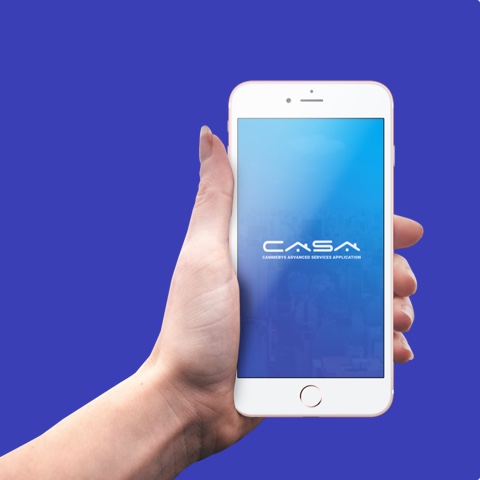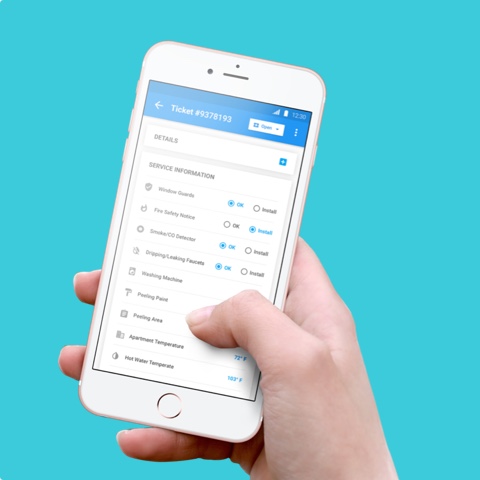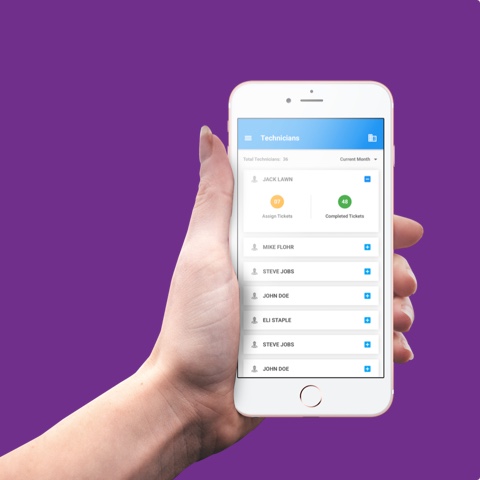The challenge of managing multiple properties is a daily reality for Cammeby’s International Group (CIG). With properties located in various cities within the Tri States and 14 other states, optimal productivity is important to their success. Keeping their employees productive means technicians attending to more repair and maintenance jobs at building sites.
Cammeby’s biggest challenge was the ability to communicate with technicians while they were out of the office about new job tickets and related information. Their existing system was paper based and included several steps. The back office communicated with managers with email and printed tickets to pass along to technicians. Technicians needed to physically come into the office to pick up work tickets. In addition, technicians were required to get tenant signatures on paperwork at the work site and then return them back to the office. The long trail of paperwork was time consuming. Tasks such as opening and closing tickets, obtaining tenant information, and getting property details, all contributed to delaying technicians from getting their work done.
But the solution to this problem became more complicated than CIG had anticipated. Looking for ways to improve communication of job tickets and related information, they contacted various vendors to help develop a mobile system. Dealing with these various vendors revealed yet another challenge. Their existing backend platform was outdated and posed problems. Some vendors required coaching and requested a mock-up of the existing system before they would begin work on the project. Creating an API as an interface to accommodate a mobile app was difficult with this old system. Disappointed with vendor responses, CIG turned to Bitbean for help.

About Cammeby's International Group
Founded in 1967, CIG is a privately held real estate development and investment firm headquartered in New York, NY. Starting with one apartment building, the firm has over $13 billion in assets, primarily in housing located in Brooklyn, Staten Island, and Queens as well as other areas throughout 14 states. Their portfolio includes industrial, office and residential real estate assets including the well-known Woolworth Building. The company has decades of experience in real estate management including industrial, commercial, and residential properties. Their business model includes in-house construction teams that provide tenants with a turn-key move-in option.



Growing need for mobility
As an owner/operator of multi-family residential and commercial properties in several states, maintaining and repairing structures is commonplace. In fact, most owners/operators of real estate and property management companies regularly juggle maintenance and repair priorities.
For CIG, the process of communicating these jobs from the back office to managers and technicians made it difficult to keep workers in the field and available for repairs. Although there was a web-based property management system in place, it generated tons of paperwork that was part of each step in the process. For example, managers were notified of job tickets available for pick up at the printer. Technicians were then required to physically check into workstations to pick up their assigned job tickets and related property information, photographs, etc. There were forms that technicians had to fill-in at the job site, which required tenant signatures once repairs were complete. All required paperwork had to be returned to the back office for manual entry. This tedious process did not offer an effective and convenient way to communicate job information to managers and technicians.
This is where Bitbean stepped in. Faced with a platform that was built over MRI Real Estate Software, the mission was clear to customize further by streamlining the process and adding mobility. Bitbean achieved this by creating an API interface and developing a mobile application. The mobile app allowed Cammeby’s managers to assign job tickets to technicians in the field. It provided users the ability to schedule, open, and close tickets along with checking project status, obtain tenant signatures, access to invoices and more.



Real challenges for the real estate firm
Increasing employee productivity by providing/improving mobile functionality is on the wish list of many companies. For property management, the need for mobility increases with the addition of properties in different geographical areas. Without it, the challenges can stunt efficiency.
Paper-based process
Although successful in providing adequate project management, the existing system relied heavily on paperwork from the beginning of the process to the end. Managers and technicians had to pick up and return various ticket forms to the back office for each assigned job.
Lack of mobility
Without the ability to stay in the field with mobile access to the project management platform, “employees were locked to their desks” and less time was spent in the field by technicians.
Old software a challenge
Providing mobility would require expertise in building a modern program interface (API) from scratch allowing for the development of and connection to a mobile application. This would require expertise in custom software development.
Lack of database
The online platform “generated a tremendous amount of paperwork” that was not stored digitally on a database for easy accessibility.
Inefficient user experience
The existing system was time consuming for employees with an average time of six minutes to complete a transaction.
Mobility brings efficiency and productivity to CIG
Following an extensive discovery process, Bitbean determined that a built-from-scratch interface was necessary to provide employees with mobility. By doing so, Bitbean was able to develop a streamlined mobile app that freed up managers and technicians to take care of business and increase productivity.




New application highlights
Complete mobility
The new mobile application was designed to “mimic the functionalities of an employee-facing web portal” so employees could stay connected on-the-go and perform job-related procedures.
Streamlined processes
Through an efficient design, Bitbean developed the mobile app to improve functionality with details and procedures available all in one place without the need for back office to enter data manually from paperwork. Auto-generated data from their custom platform provided all job ticket information and details.
Manager dashboard
Managers have an overview of all tickets open for a property and entire ticket inventory of all properties they manage. Views include the manager’s dashboard, property, building, ticket, and technician screens providing information on assigned/accepted technicians associated with jobs, time period dropdowns, opened/assigned/closed tickets, property details, photos, ticket history, etc.
Technician screen
Technicians are able to view new and existing job tickets, property details and job specifics, services drop down menus, tenant details, tenant complaints, photos and other job-ticket related information.
Accommodate multiple operating systems
The mobile app was designed and developed to work on IOS and Android operating systems.
Added database
Tons of paperwork previously generated on the old system were now stored digitally on the new database.
Custom-built interface
The existing web-based system was built using an old and outdated web program and therefore required a built-from-scratch API (interface) to work with the mobile application.
Better user experience
An intuitive and clean design of the mobile application greatly improved the user experience. Managers can receive and send job tickets, assign technicians, open and close work tickets, obtain property details, update/track ticket progress and history, and generate invoices. Technicians can reschedule projects, take and view photos, obtain tenants sign off, make calls to the tenant, and accept or cancel tickets.




Mobile app development increases productivity and efficiency
For CIG, the need for a custom software solution became increasingly apparent, particularly when the existing, web-based project management platform was keeping employees at their desks. The old process also required back office manual entry of data and in-person processing of paperwork by managers and technicians. This created productivity problems as repairs and maintenance work were delayed or interrupted by the need to check into workstations for project management tasks.
On the other hand, with the new application, employees are able to perform project management tasks away from their desktops. They can now complete a wide array of steps relating to each job ticket on their mobile devices from anywhere. This convenience allows for more time to do their work and complete more projects, which translates into greater efficiency and higher overall productivity.



